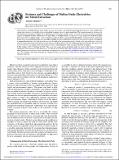Features and Challenges of Molten Oxide Electrolytes for Metal Extraction
Author(s)
Allanore, Antoine
DownloadAllanore_Features and challenges.pdf (1011.Kb)
PUBLISHER_CC
Publisher with Creative Commons License
Creative Commons Attribution
Terms of use
Metadata
Show full item recordAbstract
The electrolytic decomposition of metal oxides to metal and oxygen is an extractive metallurgy principle that, when coupled with carbon-free electricity, drastically mitigates the global warming impact of metal production. The present perspective discusses the electrochemical engineering features of an unconventional electrolyte, molten oxides. A survey of its thermodynamic properties suggests exceptional features, both in terms of applicability to multiple metals and operation at high temperature to produce liquid metal. The review of molten oxides’ transport properties indicates that an unprecedented throughput can be envisioned, a promising feature for tonnage production. However, our ability to define the optimal electrolyte composition with regard to energy consumption is rendered limited due to the lack of predictive tools for both of the reviewed properties. A look at the state of the art in electrode materials reveals that quantitative design criteria remain to be developed for both the cathode and the anode. Finally, the applications of electrochemistry in molten oxides are reviewed; thereby confirming most of the anticipated theoretical features.
Date issued
2014-11Department
Massachusetts Institute of Technology. Department of Materials Science and EngineeringJournal
Journal of the Electrochemical Society
Publisher
Electrochemical Society
Citation
Allanore, A. “Features and Challenges of Molten Oxide Electrolytes for Metal Extraction.” Journal of the Electrochemical Society 162, no. 1 (November 25, 2014): E13–E22.
Version: Final published version
ISSN
0013-4651
1945-7111